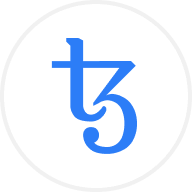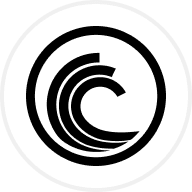
XTZ
Tezos hinta
$0,64900
-$0,01200
(−1,82 %)
Hinnanmuutos viimeisen 24 tunnin ajalta

Mitä olet mieltä XTZ-rahakkeista tänään?
Jaa tunnelmasi täällä lisäämällä peukku ylös, jos olet optimistinen kolikon suhteen, tai peukku alas, jos olet negatiivinen kolikon suhteen.
Äänestä nähdäksesi tulokset
Tezos markkinatiedot
Markkina-arvo
Markkina-arvo lasketaan kertomalla kolikon kierrossa oleva tarjonta sen viimeisellä hinnalla.
Markkina-arvo = kierrossa oleva tarjonta × viimeinen hinta
Markkina-arvo = kierrossa oleva tarjonta × viimeinen hinta
Kierrossa oleva tarjonta
Kolikon kokonaissumma, joka on julkisesti saatavilla markkinoilla.
Markkina-arvorankkaus
Kolikon sijoittuminen markkina-arvon mukaan.
Kaikkien aikojen korkein
Korkein hinta, jonka kolikko on saavuttanut treidaushistoriansa aikana.
Kaikkien aikojen alhaisin
Alin hinta, jonka kolikko on saavuttanut treidaushistoriansa aikana.
Markkina-arvo
$672,99M
Kierrossa oleva tarjonta
1 037 131 152 XTZ
98,08 % /
1 057 379 786 XTZ
Markkina-arvorankkaus
--
Auditoinnit

Viimeisin auditointi: 26.9.2022
24 h korkein
$0,66100
24 h matalin
$0,64100
Kaikkien aikojen korkein
$9,1510
−92,91 % (-$8,5020)
Viimeksi päivitetty: 4.10.2021
Kaikkien aikojen alhaisin
$0,029000
+2 137,93 % (+$0,62000)
Viimeksi päivitetty: 29.4.2019
Tezos-rahakkeiden hinnan suorituskyky valuutassa USD
Tezos-rahakkeiden nykyinen hinta on $0,64900. Kuluneen 24 tunnin aikana Tezos on laski −1,82 %. Sen tämän hetkinen kierrossa oleva tarjonta on 1 037 131 152 XTZ ja sen enimmäistarjonta on 1 057 379 786 XTZ, joten sen täysin dilutoitu markkina-arvo on $672,99M. Tällä hetkellä Tezos-kolikko on sijalla 0 markkina-arvotaulukossa. Tezos/USD-hinta päivitetään reaaliajassa.
Tänään
-$0,01200
−1,82 %
7 päivää
-$0,04680
−6,73 %
30 päivää
-$0,11680
−15,26 %
3 kuukautta
-$0,63690
−49,53 %
Suositut Tezos muunnokset
Viimeksi päivitetty: 31.03.2025 klo 11.23
| 1 XTZ --> USD | 0,64890 $ |
| 1 XTZ --> EUR | 0,59901 € |
| 1 XTZ --> PHP | 37,1554 PHP |
| 1 XTZ --> IDR | 10 762,98 IDR |
| 1 XTZ --> GBP | 0,50069 £ |
| 1 XTZ --> CAD | 0,92864 CAD |
| 1 XTZ --> AED | 2,3834 AED |
| 1 XTZ --> VND | 16 595,91 VND |
Lisätietoja: Tezos (XTZ)
Arvostelu on OKX:n tarjoamista lähteistä kokoama yhteenlaskettu arvostelu, ja se on tarkoitettu vain tiedoksi. OKX ei takaa arvostelujen laatua tai tarkkuutta. Sen tarkoituksena ei ole tarjota (i) sijoitusneuvontaa tai -suositusta, (ii) tarjousta tai kehotusta ostaa, myydä tai pitää hallussa digitaalisia varoja tai (iii) taloudellista, kirjanpidollista, oikeudellista tai veroperusteista neuvontaa. Digitaalisiin varoihin, kuten vakaakolikkoihin ja NFT:ihin, liittyy suuri riski, niiden arvo voi vaihdella suuresti ja niistä voi jopa tulla arvottomia. Digitaalisten varojen hintaa ja tuottoa ei ole taattu, ja ne voivat muuttua ilman ennakkoilmoitusta. Digitaalisia varojasi ei ole vakuutettu mahdollisten tappioiden varalta. Aiemmat tuotot eivät ole osoitus tulevista tuotoista. OKX ei takaa tuottoa eikä pääoman tai korkojen takaisinsaamista. OKX ei tarjoa sijoitus- tai omaisuussuosituksia. Sinun on harkittava huolellisesti, sopiiko digitaalisten varojen treidaus tai hallussapito sinulle ottaen huomioon taloudellisen tilanteesi. Ota yhteyttä laki-/vero-/sijoitusalan ammattilaiseen, jos sinulla on kysyttävää omaan tilanteeseesi liittyen.
Näytä lisää
- Virallinen verkkosivusto
- White paper
- Github
- Lohkoketjutyökalu
Tietoa kolmansien osapuolten verkkosivustoista
Tietoa kolmansien osapuolten verkkosivustoista
Käyttämällä kolmannen osapuolen verkkosivustoa hyväksyt, että kolmannen osapuolen verkkosivuston käyttöön sovelletaan kolmannen osapuolen verkkosivuston ehtoja. Ellei nimenomaisesti kirjallisesti mainita, OKX ja sen tytäryhtiöt (”OKX”) eivät ole millään tavalla yhteydessä kolmannen osapuolen verkkosivuston omistajaan tai ylläpitäjään. Hyväksyt, että OKX ei ole vastuussa mistään menetyksistä, vahingoista tai muista seurauksista, jotka johtuvat kolmannen osapuolen verkkosivuston käytöstäsi. Huomaa, että kolmannen osapuolen verkkosivuston käyttö voi johtaa varojesi menettämiseen tai vähenemiseen.
Tezos UKK
Kuinka paljon 1 Tezos on arvoltaan tänään?
Tällä hetkellä yksi Tezos on arvoltaan $0,64900. Jos haluat vastauksia ja tietoa Tezos-rahakkeen hintakehityksestä, olet oikeassa paikassa. Tutustu uusimpiin Tezos-kaavioihin ja treidaa vastuullisesti OKX:ssä.
Mikä on kryptovaluutta?
Kryptovaluutat, kuten Tezos, ovat digitaalisia varoja, jotka toimivat lohkoketjuiksi kutsutussa julkisessa pääkirjassa. Lue lisää OKX:ssä tarjottavista kolikoista ja rahakkeista ja niiden eri ominaisuuksista, joihin kuuluvat reaaliaikaiset hinnat ja reaaliaikaiset kaaviot.
Milloin kryptovaluutta keksittiin?
Vuoden 2008 finanssikriisin ansiosta kiinnostus hajautettua rahoitusta kohtaan kasvoi. Bitcoin tarjosi uudenlaisen ratkaisun olemalla turvallinen digitaalinen vara hajautetussa verkossa. Sittemmin on luotu myös monia muita rahakkeita, kuten Tezos.
Nouseeko Tezos-rahakkeiden hinta tänään?
Tutustu Tezos-rahakkeiden hintaennustesivu nähdäksesi tulevien hintojen ennusteet ja määrittääksesi hintatavoitteesi.
ESG-tiedonanto
Kryptovaroja koskevien ESG-säännösten (Environmental, Social ja Governance) tavoitteena on puuttua niiden ympäristövaikutuksiin (esim. energiaintensiivinen louhinta), edistää avoimuutta ja varmistaa eettiset hallintokäytännöt, jotta kryptoala olisi linjassa laajempien kestävyyteen ja yhteiskuntaan liittyvien tavoitteiden kanssa. Näillä säännöksillä kannustetaan noudattamaan standardeja, jotka lieventävät riskejä ja edistävät luottamusta digitaalisiin varoihin.
Varan tiedot
Nimi
OKcoin Europe LTD
Asianomaisen oikeudellisen tahon tunniste
54930069NLWEIGLHXU42
Kryptovaran nimi
Tezos
Konsensusmekanismi
Tezos is present on the following networks: binance_smart_chain, tezos.
Binance Smart Chain (BSC) uses a hybrid consensus mechanism called Proof of Staked Authority (PoSA), which combines elements of Delegated Proof of Stake (DPoS) and Proof of Authority (PoA). This method ensures fast block times and low fees while maintaining a level of decentralization and security. Core Components 1. Validators (so-called “Cabinet Members”): Validators on BSC are responsible for producing new blocks, validating transactions, and maintaining the network’s security. To become a validator, an entity must stake a significant amount of BNB (Binance Coin). Validators are selected through staking and voting by token holders. There are 21 active validators at any given time, rotating to ensure decentralization and security. 2. Delegators: Token holders who do not wish to run validator nodes can delegate their BNB tokens to validators. This delegation helps validators increase their stake and improves their chances of being selected to produce blocks. Delegators earn a share of the rewards that validators receive, incentivizing broad participation in network security. 3. Candidates: Candidates are nodes that have staked the required amount of BNB and are in the pool waiting to become validators. They are essentially potential validators who are not currently active but can be elected to the validator set through community voting. Candidates play a crucial role in ensuring there is always a sufficient pool of nodes ready to take on validation tasks, thus maintaining network resilience and decentralization. Consensus Process 4. Validator Selection: Validators are chosen based on the amount of BNB staked and votes received from delegators. The more BNB staked and votes received, the higher the chance of being selected to validate transactions and produce new blocks. The selection process involves both the current validators and the pool of candidates, ensuring a dynamic and secure rotation of nodes. 5. Block Production: The selected validators take turns producing blocks in a PoA-like manner, ensuring that blocks are generated quickly and efficiently. Validators validate transactions, add them to new blocks, and broadcast these blocks to the network. 6. Transaction Finality: BSC achieves fast block times of around 3 seconds and quick transaction finality. This is achieved through the efficient PoSA mechanism that allows validators to rapidly reach consensus. Security and Economic Incentives 7. Staking: Validators are required to stake a substantial amount of BNB, which acts as collateral to ensure their honest behavior. This staked amount can be slashed if validators act maliciously. Staking incentivizes validators to act in the network's best interest to avoid losing their staked BNB. 8. Delegation and Rewards: Delegators earn rewards proportional to their stake in validators. This incentivizes them to choose reliable validators and participate in the network’s security. Validators and delegators share transaction fees as rewards, which provides continuous economic incentives to maintain network security and performance. 9. Transaction Fees: BSC employs low transaction fees, paid in BNB, making it cost-effective for users. These fees are collected by validators as part of their rewards, further incentivizing them to validate transactions accurately and efficiently.
Tezos operates on a Liquid Proof of Stake (LPoS) consensus mechanism, which combines flexibility in staking participation with an on-chain governance model. Core Components: Liquid Proof of Stake (LPoS) Tezos allows token holders to participate in staking by either directly staking their tokens or delegating them to a validator (known as a baker) without transferring ownership. Validators (bakers) are responsible for creating new blocks (baking) and endorsing other blocks for validation. Bakers and Endorsers Bakers are selected based on the amount of XTZ (Tezos tokens) staked or delegated to them. The more XTZ staked, the higher the probability of being chosen to bake or endorse blocks. Endorsers are randomly selected from a pool of bakers to validate and approve blocks baked by other bakers. This additional validation enhances network security. Self-Amendment and Governance Tezos’s unique governance model allows token holders to propose, vote on, and implement network upgrades without requiring hard forks. This self-amendment protocol enables Tezos to evolve based on community and developer input, making it highly adaptable and flexible.
Kannustinmekanismit ja sovellettavat maksut
Tezos is present on the following networks: binance_smart_chain, tezos.
Binance Smart Chain (BSC) uses the Proof of Staked Authority (PoSA) consensus mechanism to ensure network security and incentivize participation from validators and delegators. Incentive Mechanisms 1. Validators: Staking Rewards: Validators must stake a significant amount of BNB to participate in the consensus process. They earn rewards in the form of transaction fees and block rewards. Selection Process: Validators are selected based on the amount of BNB staked and the votes received from delegators. The more BNB staked and votes received, the higher the chances of being selected to validate transactions and produce new blocks. 2. Delegators: Delegated Staking: Token holders can delegate their BNB to validators. This delegation increases the validator's total stake and improves their chances of being selected to produce blocks. Shared Rewards: Delegators earn a portion of the rewards that validators receive. This incentivizes token holders to participate in the network’s security and decentralization by choosing reliable validators. 3. Candidates: Pool of Potential Validators: Candidates are nodes that have staked the required amount of BNB and are waiting to become active validators. They ensure that there is always a sufficient pool of nodes ready to take on validation tasks, maintaining network resilience. 4. Economic Security: Slashing: Validators can be penalized for malicious behavior or failure to perform their duties. Penalties include slashing a portion of their staked tokens, ensuring that validators act in the best interest of the network. Opportunity Cost: Staking requires validators and delegators to lock up their BNB tokens, providing an economic incentive to act honestly to avoid losing their staked assets. Fees on the Binance Smart Chain 5. Transaction Fees: Low Fees: BSC is known for its low transaction fees compared to other blockchain networks. These fees are paid in BNB and are essential for maintaining network operations and compensating validators. Dynamic Fee Structure: Transaction fees can vary based on network congestion and the complexity of the transactions. However, BSC ensures that fees remain significantly lower than those on the Ethereum mainnet. 6. Block Rewards: Incentivizing Validators: Validators earn block rewards in addition to transaction fees. These rewards are distributed to validators for their role in maintaining the network and processing transactions. 7. Cross-Chain Fees: Interoperability Costs: BSC supports cross-chain compatibility, allowing assets to be transferred between Binance Chain and Binance Smart Chain. These cross-chain operations incur minimal fees, facilitating seamless asset transfers and improving user experience. 8. Smart Contract Fees: Deployment and Execution Costs: Deploying and interacting with smart contracts on BSC involves paying fees based on the computational resources required. These fees are also paid in BNB and are designed to be cost-effective, encouraging developers to build on the BSC platform.
Tezos incentivizes network participation and security through baking rewards, transaction fees, and an inflationary reward model. Incentive Mechanisms: Rewards for Baking and Endorsing Bakers receive XTZ rewards for baking new blocks. Endorsers, who validate and approve blocks baked by others, are also rewarded in XTZ. These rewards encourage active participation and help secure the network. Delegation Incentives XTZ holders who do not wish to bake can delegate their tokens to a baker, earning a share of the baker’s rewards without directly participating. This delegation option broadens participation, making it accessible to more users, thereby enhancing overall network security. Security Deposit Requirement Bakers are required to post a bond (security deposit) in XTZ to bake blocks, which is held as collateral to prevent dishonest actions. If a baker acts maliciously, they risk forfeiting this bond, creating a disincentive for bad behavior and aligning bakers’ interests with network integrity. Applicable Fees: Transaction Fees Users pay transaction fees in XTZ for activities such as transferring funds and interacting with smart contracts. These fees are awarded to bakers and endorsers, providing them with an additional incentive to validate and secure the network. Inflationary Reward Model Tezos has an inflationary reward system, where new XTZ tokens are periodically created and distributed as rewards to bakers and endorsers. This model encourages continuous participation but gradually increases the XTZ supply, balancing network security and token availability over time.
Sen kauden alku, jota ilmoitus koskee
2024-03-28
Sen kauden päättyminen, jota ilmoitus koskee
2025-03-28
Energiaraportti
Energian kulutus
282249.51698 (kWh/a)
Energiankulutuksen lähteet ja menetelmät
The energy consumption of this asset is aggregated across multiple components:
For the calculation of energy consumptions, the so called “bottom-up” approach is being used. The nodes are considered to be the central factor for the energy consumption of the network. These assumptions are made on the basis of empirical findings through the use of public information sites, open-source crawlers and crawlers developed in-house. The main determinants for estimating the hardware used within the network are the requirements for operating the client software. The energy consumption of the hardware devices was measured in certified test laboratories. When calculating the energy consumption, we used - if available - the Functionally Fungible Group Digital Token Identifier (FFG DTI) to determine all implementations of the asset of question in scope and we update the mappings regulary, based on data of the Digital Token Identifier Foundation.
To determine the energy consumption of a token, the energy consumption of the network(s) binance_smart_chain is calculated first. Based on the crypto asset's gas consumption per network, the share of the total consumption of the respective network that is assigned to this asset is defined. When calculating the energy consumption, we used - if available - the Functionally Fungible Group Digital Token Identifier (FFG DTI) to determine all implementations of the asset of question in scope and we update the mappings regulary, based on data of the Digital Token Identifier Foundation.
The following sources where used: tzStats
Vastuuvapauslauseke
Tällä sivulla oleva sosiaalinen sisältö (”sisältö”), mukaan lukien muun muassa LunarCrushin tarjoamat twiitit ja tilastot, on peräisin kolmansilta osapuolilta ja se tarjotaan sellaisenaan vain tiedotustarkoituksiin. OKX ei takaa sisällön laatua tai tarkkuutta, eikä sisältö edusta OKX:n näkemyksiä. Sen tarkoituksena ei ole tarjota (i) sijoitusneuvontaa tai -suosituksia, (ii) tarjousta tai kehotusta ostaa, myydä tai pitää hallussa digitaalisia varoja tai (iii) rahoitus-, kirjanpito-, laki- tai veroneuvontaa. Digitaaliset varat, mukaan lukien vakaakolikot ja NFT:t, sisältävät suuren riskin ja niiden hinta voi vaihdella suuresti. Digitaalisten varojen hintaa ja suorituskykyä ei voida taata, ja ne voivat muuttua ilman ennakkoilmoitusta. OKX ei anna sijoitus- tai omaisuussuosituksia. Sinun tulisi harkita huolellisesti, onko digitaalisten varojen treidaus tai hallussapito sinulle sopivaa oman taloudellisen tilanteesi valossa. Ota yhteyttä laki-/vero-/sijoitusasiantuntijaan, jos sinulla on kysyttävää omaan tilanteeseesi liittyen. Lisätietoja on käyttöehdoissa ja riskivaroituksessa. Käyttämällä kolmannen osapuolen verkkosivustoa hyväksyt, että sen käyttöön sovelletaan kolmannen osapuolen ehtoja. Ellei nimenomaisesti kirjallisesti mainita, OKX ja sen tytäryhtiöt (”OKX”) eivät ole millään tavalla yhteydessä kolmannen osapuolen verkkosivuston omistajaan tai ylläpitäjään. Hyväksyt sen, että OKX ei ole vastuussa mistään menetyksistä, vahingoista tai muista seurauksista, jotka johtuvat kolmannen osapuolen verkkosivuston käytöstäsi. Huomaa, että kolmannen osapuolen verkkosivuston käyttö voi johtaa varojen menettämiseen tai vähenemiseen. Tuote ei ehkä ole käytettävissä kaikilla lainkäyttöalueilla.











Sosiaaliset tiedot